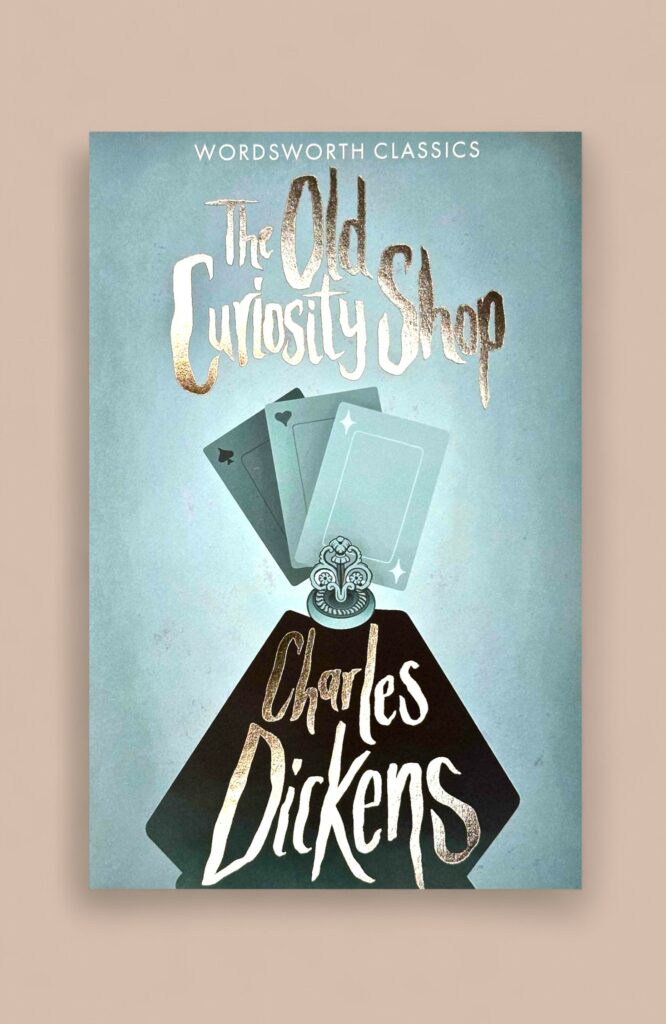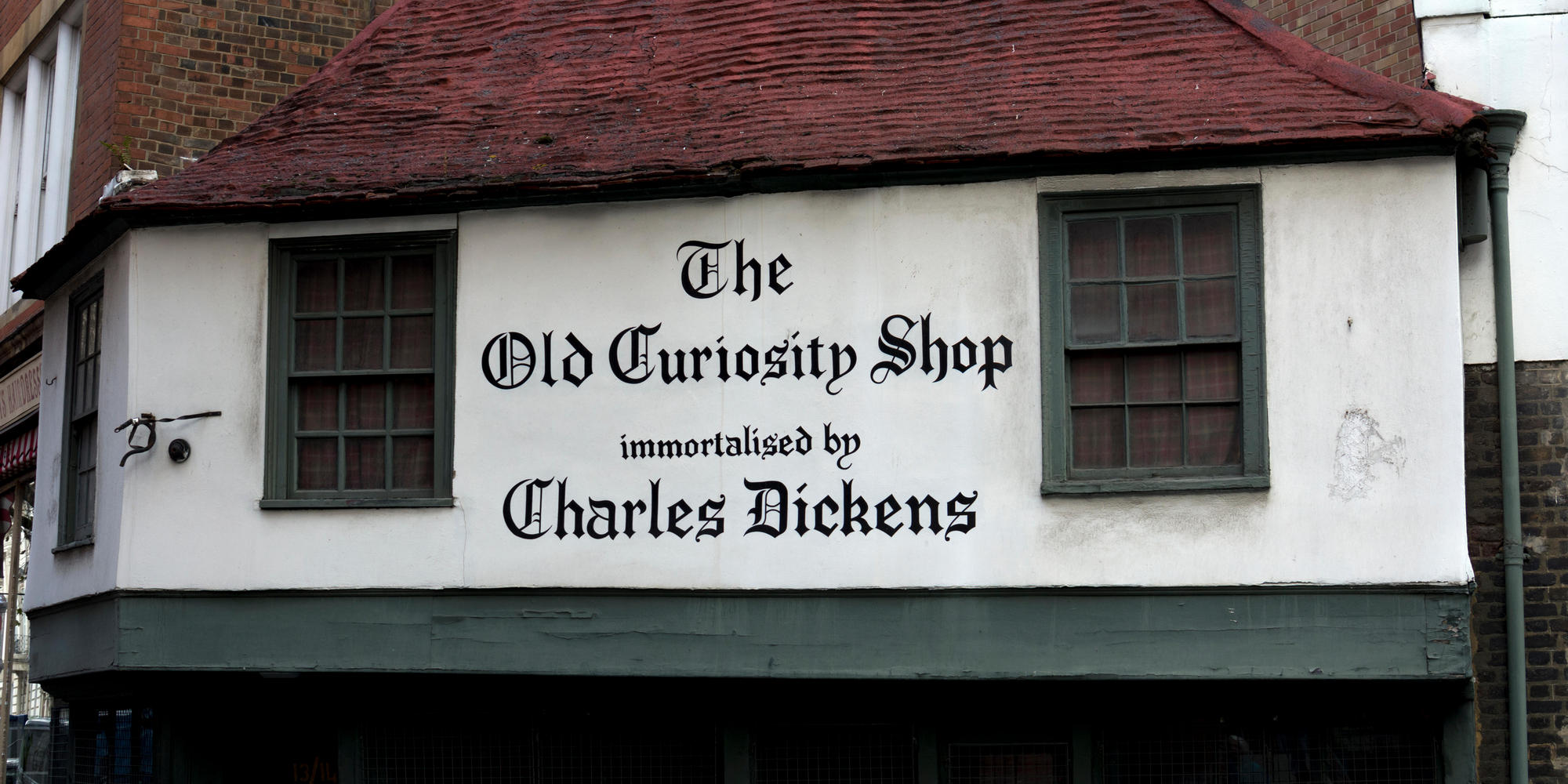
The Old Curiosity Shop by Charles Dickens
David Ellis revisits Charles Dickens’ fourth novel, The Old Curiosity Shop
Dickens’s novels are full of members of the older generation who fail in their obligations to the young. It is if he could never quite forgive or forget how in the early 1820s his indebted parents took him out of school, when he was still only twelve, and sent him to work in a factory, attaching labels to pots of boot polish. It was two years before this excursion over the line that separates the lower middle from the working classes ended and his parents’ finances were sufficiently recovered to send him back to school again. What must have made it particularly galling for him was that they had in the meantime managed to scrape together enough money (or credit) to send his slightly older sister to music school. Perhaps they felt that she possessed talents that were more potentially marketable than any demonstrated by Charles who, at this early stage, was chiefly remarkable for his renderings of comic songs. If that was in fact part of their motivation, never can two parents have been so spectacularly wrong.
In The Old Curiosity Shop, the older person who lets down little Nell, and could reasonably be said to be the cause of her early death, is her grandfather. Old man Trent, as he is sometimes called, is devoted to Nell and claims that the reason he makes nightly visits to a gambling den is only so that he can win enough money to allow her to live in luxury. But that is no more than a cover for what is brilliantly dramatized by Dickens as a full-blown addiction. Anyone who doubts that gambling can be just as powerful a disorder as taking drugs should read chapters 29 and 30 of this novel in which Nell and her grandfather are caught in a storm and seek shelter in a pub where there are men playing cards for money. The mere sight of them reignites all the old man’s cravings and he not only loses the little money Nell is able to give him but creeps into her bedroom that night to steal the remaining coins she was hiding away. The two wanderers had previously been lucky enough to find a refuge with Mrs Jarley, who runs a travelling waxwork show, but the grandfather’s further association with the gamblers in the pub means that he begins to think of feeding his addiction by stealing from her and Nell has therefore to persuade him that they must leave the safe berth they have found and set off on their travels again. The hardships of a life on the road, together with the responsibilities of looking after her grandfather, who is developing dementia, undermine her health and lead to one of the most famous deaths in British literary history, comparable in many people’s eyes to that of Shakespeare’s Cordelia. The Old Curiosity Shop, Dickens’s friend and biographer Forster wrote, greatly increased the sense of his powers `as a pathetic as well as humorous writer’ but one striking feature of the pathos he is able to generate is that he avoids describing Nell’s death directly but only through its effects on the people around her.
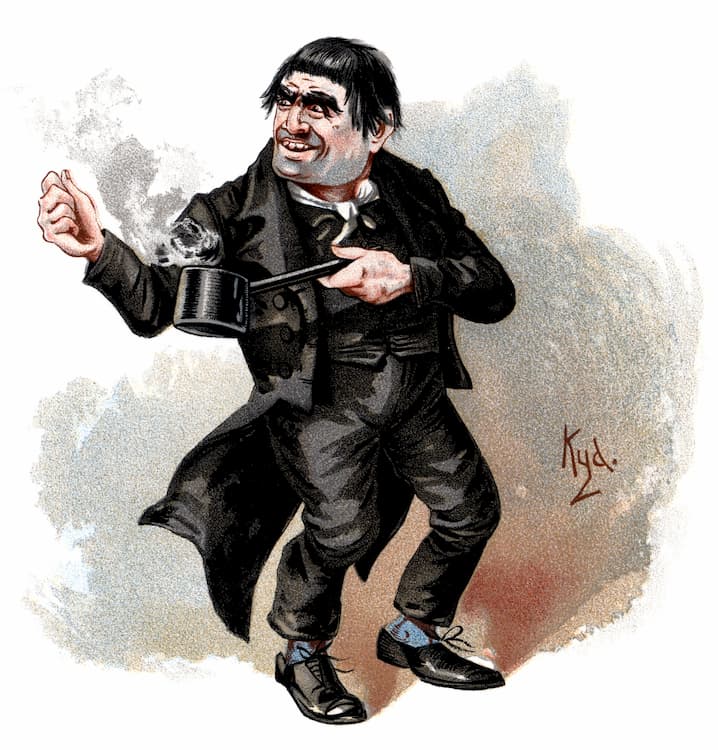
Quilp
Nell and her grandfather have taken to the road because the shop of old curiosities which was their home in London has fallen into the hands of the man from whom Trent has been borrowing money to sustain his gambling. Quilp is this money lender’s name and he is the first of Dickens’s characters, in what is his fourth novel, who could legitimately be described as grotesque. That term had gained some of its currency in his own time from one of the founding texts of European Romanticism: Victor Hugo’s long preface to his play about Oliver Cromwell, first published in 1827. Opposing the grotesque to the sublime, Hugo had claimed that it is in the former we find the germ of all comedy, both in the general sense and as a dramatic genre. It was a term that had of course long been associated with architecture and what is now one of our own clearest senses of it perhaps comes from those faces and figures carved into odd corners of medieval churches, but particularly on their gargoyles. These tend to have several characteristics found in Dickens’s descriptions of Quilp. He is in the first place spectacularly ugly with the exaggerated facial features often found in the church sculptures or carvings but then also physically mishappen, with a large head and legs short enough to qualify him as a dwarf. The carvings often take on the appearance of animals and although Quilp’s appearance is compared to many different kinds of animal his antics are also animal-like, hanging upside down, sleeping on top of furniture and threatening to bite. Like many of those images in church, he is a reminder of that closeness to the animal world above which we can imagine ourselves elevated by our religious beliefs. The Old Curiosity Shop
The church carvings are also a reminder of the pagan elements Christianity was able to incorporate as it marched triumphantly across the Western world in that they often seem like the little devils or evil spirits familiar to us from folklore. Quilp is also devil-like and with apparently the same power those devils have of appearing quite unexpectedly, out of nowhere. He also has a devil’s instinctive hostility to the good, as it is personified in this novel by Kit Nubbles whose misfortunes he derives a malignant joy from promoting although Dickens does not neglect to also provide us with an additional, more psychological motive for his hostility. Quilp can never forget how, in one of their early quarrels, Kit has called him `the ugliest dwarf that can be seen anywhere for a penny’. He is referring to what were called `freak shows’ in which individuals with physical characteristics outside the conventional biological norms were exhibited to, and sometimes interacted with, paying customers. That these were popular in Victorian England was amply documented in 2012 by Nadja Durbach in her Spectacle of Deformity: Freak Shows and Modern British Culture. The Old Curiosity Shop
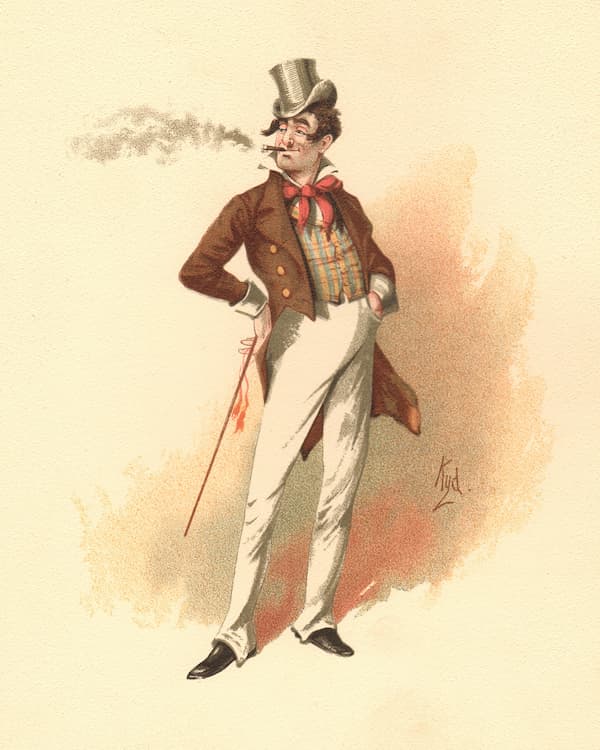
Dick Swiveller
It is before they are taken in by the lady with the waxworks that Nell and her grandfather come across the proprietor of a freak show as well as two men who operate a punch and judy and another who has with him five performing dogs. With his sympathy for all forms of popular entertainment, Dickens treats the freak show owner comically. Travelling with only one giant and `a little lady without legs or arms’ he complains that his giant is becoming worryingly weak at the knees. When that happens and they can no longer stand up straight, giants become useless, he says, whereas `the older a dwarf is, the better worth he is’. The discussion becomes general about the advisability of keeping old giants away from the public, rather than `lettin’ them go upon the parish’, because `once make a giant common and giants will never draw again’, the examples then cited of the dangers of over-exposure being people with wooden legs. `If you was to advertise Shakespeare played entirely by wooden legs’, says the freak show proprietor, `it’s my belief you wouldn’t draw a sixpence’. This is a joke that not only suggest how many men with wooden legs Dickens must have seen in his youth, after the Napoleonic wars, but also pits our sense of humour against our empathy although not so effectively as Mrs Gamp’s claim, in Martin Chuzzlewit, that her dead husband had a wooden leg which in `its constancy of walking into wine vaults, and never coming out again till fetched by force, was quite as weak as flesh if not weaker’.
Quilp’s malice is no doubt partly fuelled by the response others have to his physical appearance but that does not prevent him from glorying in the effects it has or being immensely pleased and satisfied with himself. Like Shakespeare’s Richard III, he delights in the success of his plots and exhibits a similar energy in attempting to bring them about. There is also in him a similar manic cheerfulness although whether that makes him comic, as Hugo’s definition of the grotesque would suggest it should, is doubtful. Claiming that all humour has in it `what ordinary people are apt to call exaggeration’, Forster wrote that in Dickens’s case there were times when he was inclined to magnify, `out of proper bounds’, his sense of what was droll and `put the merely grotesque in its place’. This is to contrast comedy with the grotesque rather than seeing the two as integral to each other, as Hugo does, and there are aspects of Quilp’s character and behaviour which are clearly not funny at all. `Coercive control’ is an expression that has only recently come into the language (and the legal system) but if anyone is doubtful about what it means they would only have to consult Quilp’s appalling treatment of his wife. Docile and pretty as she is (like Richard III, Quilp is represented as having a way with women), he thinks of getting rid of her and marrying instead Nell once she is a little older and, in the first part of the novel, he is a hovering, and peculiarly repulsive, sexual threat. The Old Curiosity Shop
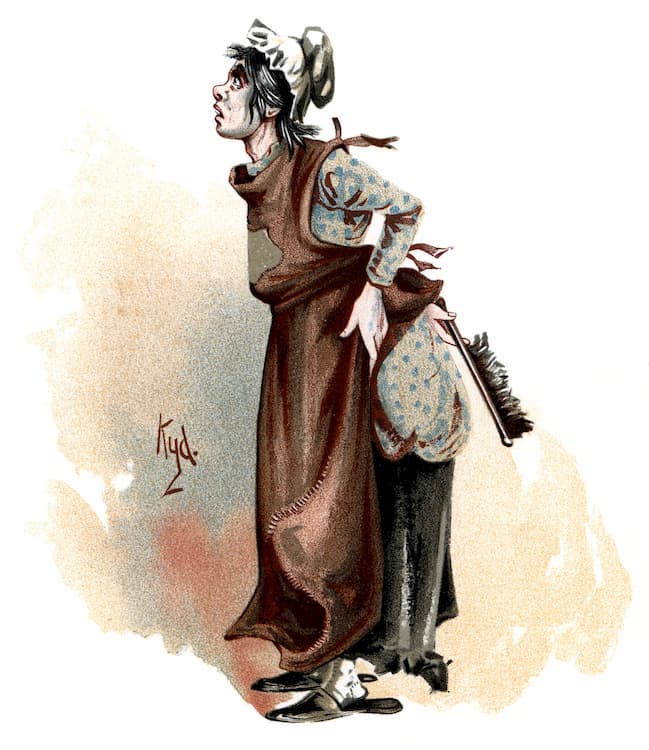
The Marchioness
Although the conventions of the time lead him to work chiefly through suggestion, Dickens was alert to how very young girls who were obliged to roam the streets, and had no secure home or protection, were vulnerable to sexual exploitation. Because Nell’s grandfather is always talking about how one day she will be a great lady, there is a general assumption that, in spite of the miserably poor way in which he lives, the old man has hidden away a huge stack of money. Her good-for -nothing older brother has a scheme for eventually profiting from this stack which involves persuading his feckless, manipulatable but essentially good-natured friend, Dick Swiveller, that he should marry Nell once the time is ripe. Along with Quilp therefore, Dick is waiting for Nell to grow up but of course, like Oliver Twist, she never does. It seems essential to Dickens’s concept of her as an unusually attractive and angelic child that she should hover around the borders of puberty but die before she is able to cross them. In his excellent introduction to the Wordsworth edition of The Old Curiosity Shop, Peter Preston reminds us of the huge outpouring of national grief that followed Dickens’s decision to have her die although he also quotes Oscar Wilde’s famous remark that any man would have to have a heart of stone to read about her death without laughing. This is that reversal of commonly accepted values on which so much of Wilde’s wit depends although it is much less successful here than in, for example, Lady Bracknell’s well-known defence of `natural ignorance’ in The Importance of Being Earnest (touch it and the bloom is gone). There is one episode before Nell’s death, when a little boy in the village where she and her grandfather have found a final home, and who has recently lost an elder brother, begs her not to leave them all and join the angels since that is what he has heard adults say she must shortly do. It is one almost too cloyingly sentimental to get through. Yet her death itself is, as I have said, treated at a distance so that the only major complaint one might have is that we are asked to sympathise with the grandfather, in his now totally bereft and bewildered state, and forget that (as I have also said!) he has been at the root of all Nell’s troubles from the start. The Old Curiosity Shop
Main image: The Old Curiosity Shop, Portsmouth Street, London Credit: Colin Underhill / Alamy Stock Photo
Images 1-3 above: Daniel Quilp, Dick Swiveller and The Marchioness by ‘Kyd’ (Joseph Clayton Clarke) Credit: Select Images (1 & 3), Antiquarian Images (2) All Alamy Stock Photos
Our edition of The Old Curiosity Shop for £3.99 is here: Old Curiosity Shop – Wordsworth Editions
There are many societies devoted to the works of Charles Dickens, including https://www.dickensfellowship.org/
The Old Curiosity Shop
Books associated with this article
